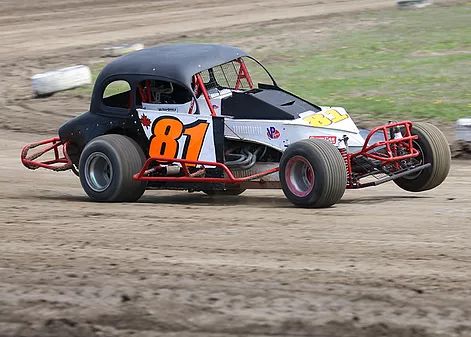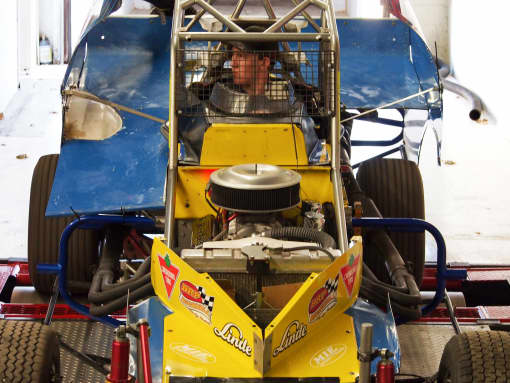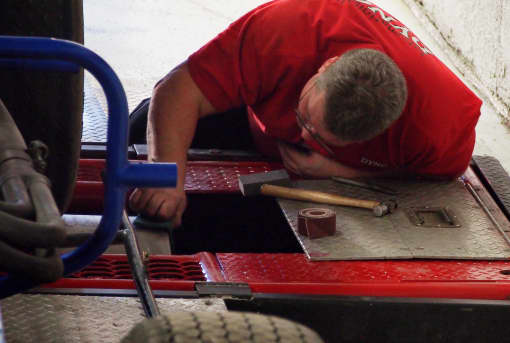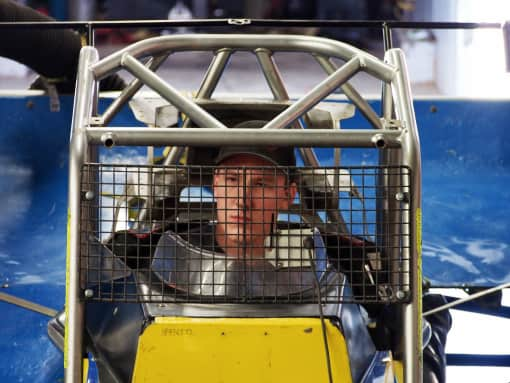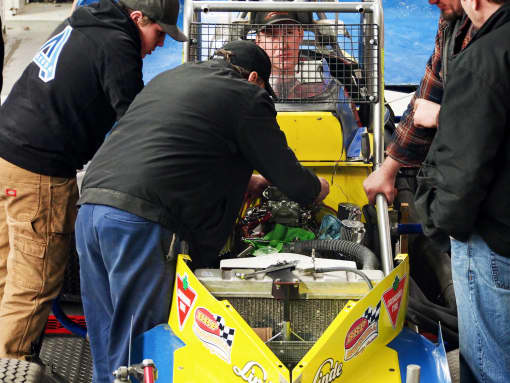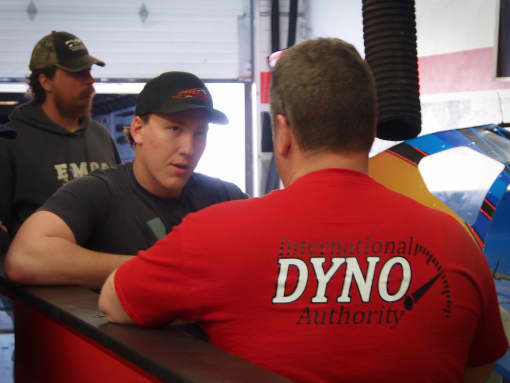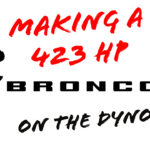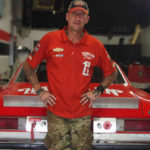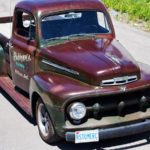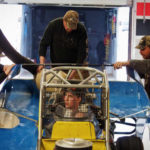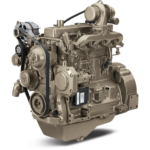chassis dyno ENGINE BREAK-IN
INITIAL BREAK-IN & WARM UP
Tyler’s crew started the break-in process with a warm-up on the road in front of their rural home. Followed by an oil change, loading the trailer, and an hour-and-a-half drive to International Dyno Authority in Ottawa.
Class: Sportsman
Engine: 2018 Chev 350cu. in. 602 sealed
Frame & Suspension: 2007 Bicknell Frame and suspension
Carb: Holly 650 4-Barrel
Differential: Winters Quick Change (tested at 5.8:1)
Transmission: Falcon
WARM-UP & BASELINE PASSES
When Tyler and his crew (Jason Reynolds, Evan Reynolds, Paul Pekkonen, and Carl Jobson) arrived at International Dyno Authority, they got straight to work strapping down the stock car and performing a thorough visual inspection. Then it was time to begin warming up the 602. The 602 is a cold running motor, so we let it run on the dyno for a while until it reached an operating temp. of 160+ degrees Fahrenheit.
Next, we did an initial shakedown to ensure all systems were operating correctly and to get a baseline. We did three passes beginning at 2,000 RPM and finished at 4,000 RPM.
Next, we shut down for a thorough inspection of all components to ensure there were no fluid leaks, loose bolts or other issues.
BREAK-IN
Now it was time to start the break-in passes.
Unfortunately, after the first few passes, the pickup magnet on the dyno lost its magnetism and stopped transmitting data. One hour, and four large pizzas later, the dyno and the team were ready to start again.
By the tenth pass, with the rings set into the cylinder hones, the torque increase was 95 ft-lbs., over baseline, with a power gain of 128 HP.
Now with the engine at racing temperature, the next ten passes consistently produced 89 ft-lbs, and 113 HP over the baseline results, with the drop in power attributable to the higher operating temperature.
JETTING ADJUSTMENT
Since the engine had demonstrated some fluttering on the previous passes, the pit crew dropped the jetting – reducing the back jets from 77 to 67 and the front jets from 74 to 62.
With the carb leaned out, Tyler made another ten passes, and the 602 stopped fluttering but delivered the same results – pass-after-pass – of 98 ft-lbs. and 113 HP over baseline. Likewise, setting up an air breather with a vented lid did not affect any change in the data.
2-barrel test
Though Tyler will never run a 2-barrel on this car, he wanted a rough idea of what the engine could put-out in the Vintage Class. So, the crew switched-out the Holly 650, 4-barrel for a 2-barrel version.
With the reduced airflow of the 2-barrel, the engine produced 40 fewer ft-lbs and HP dropped by 38; however, the engine became much more responsive. The lower-end RPM range demonstrated a cleaner ability to pick-up RPM and the carbs overall performance was jetted closer and with better fuel settings.
Wrapping-up
With the break-in and testing completed, Marc and the crew spent some time reviewing the results. Overall, everyone agreed that, once properly broken-in on the dyno, the 602 delivered as promised by the manufacturer. The dyno results showed very little power loss between the gears and the wheels, so the 602 may have actually exceeded the manufacturer’s guaranteed specs.
Five-hours after arriving, the crew packed-up and prepared for the long drive home with properly seated rings and an accurate picture of the power range this car could deliver.
TYLER REYNOLDS
Nineteen-year-old Tyler Reynolds inherited his love for speed from his father, Jason Reynolds, who raced street stock in the 90’s. Jason stopped racing after his kids were born so he could focus on raising his family, but he never lost his enthusiasm for the sport and has passed it on to his boys. Tyler says his love for the sport comes from the thrill of experiencing the raw power of the engine on the track.
Go-Kart Racing
When Tyler was 11 years old, his father set him up in a flathead Briggs & Stratton go-cart, burning methanol fuel and kitted-out with an aluminium flywheel and rods, the cart made about 12 HP on the oval dirt track.
Tyler was immediately hooked on racing. With dad, mom, and younger brother Evan acting as pit crew, Tyler spent the next four seasons on dirt oval tracks at the Brockville Speedway, Cornwall Speedway, and in the US at tracks like Can-Am, Route 58, and the Paradise.
By Tyler’s third go-cart season, then 9-year-old Evan, was also racing. That year, both brothers finished the season second overall in their respective divisions.
SPORTSMAN STOCK CAR RACING
In 2014, when Tyler was 15-years-old, he moved up to Stock Car racing, running a Chevy 350 cu. in., 602 sealed crate motor on a Bicknell frame with a Winters rear-end and a Falcon 2-speed transmission.
Tyler’s pit crew has expanded to include long-time family friend and Sprint Car racer, Paul Pekkonen. Tyler was also supported by Jeff Ciglich – a former Modified Stock Car racer, who helped with setups and scaling, and from Derrick Flynn who, together with Jeff, run the Dirt Modified Nostalgia Tour.
But, for the coming 2018 season, Tyler has decided to switch back to his real passion – Stock Car racing. He’s hoping the skills he developed driving the more difficult to hold, open-bodied vintage coupe will translate into a successful 2018 season.
